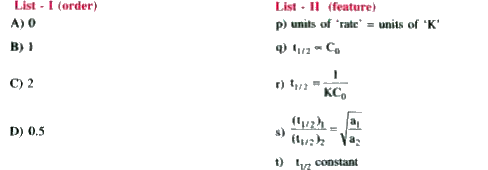An organic compound A decomposes following two parallel first order reactions
K
2/
K
1
=9/1
and K
1
=1.3×10
−5
sec
−1

If an experiment is started with A for one hour, the ratio of B to A is Solution in Telugu
0.1
0.15
0.5
0.25
The correct Answer is:C
Use yByA=[K1×xK]…….(1) after hr x=2.C03….2 So 1 and 2 (yByA)=0.2
Topper's Solved these Questions
- CHEMICAL KINETICSBOOK - AAKASH SERIESCHAPTER - CHEMICAL KINETICSEXERCISE - LEVEL-II(LECTURE SHEET EXERCISE-II LINKED COMPREHENSION TYPE QUESTIONS)
9 Videos
- CHEMICAL KINETICSBOOK - AAKASH SERIESCHAPTER - CHEMICAL KINETICSEXERCISE - LEVEL-II(LECTURE SHEET EXERCISE-III MATCH THE FOLLOWING QUESTIONS)
3 Videos
- CHEMICAL KINETICSBOOK - AAKASH SERIESCHAPTER - CHEMICAL KINETICSEXERCISE - LEVEL-1 (EXERCISE -II ORDER, MOLECULARITY, HALF LIFE:)
34 Videos
- CHEMICAL KINETCSBOOK - AAKASH SERIESCHAPTER - CHEMICAL KINETCSEXERCISE - EXERCISE - 3.2
45 Videos
- CHEMICAL THERMODYNAMICSBOOK - AAKASH SERIESCHAPTER - CHEMICAL THERMODYNAMICSEXERCISE - Additional Practice Exercise
54 Videos
Similar Questions
A certain endothermic reaction: A→ Product, ΔH=+ve proceeds ina sequence of three elementary steps with the rate constant K1,K2 and K3 and each one having energy of activation E1,E2 and E3 respectively at 25∘C. The observed rate constannt for the reaction is equal to K3√K1K2.
A1,A2 and A3 are Arrhenius parameters respectively.
The observed energy of activation for the reaction is
View SolutionMatch the following columns

View SolutionSucrose decompose in acid solution into glucose and fructose according to the first order rate law, with t12=3.00 hours. What fraction of sample of sucrose remains after 8 hours ?
View SolutionDiscuss on the kinetic spontaneity of a chemical reaction. Is a slow reaction spontaneous? Why?
View SolutionWhich among the following is not an exact differential?
View Solution(1)/(1! 10!)+(1)/(2! 9!)+(1)/(3 !! g!) ++ (1)/(1! 10!) = (2)/ (k!) (2^(k-1) -1)
View SolutionIf secθ+tanθ=k, cosθ=
a.k2+12k b. 2kk2+1 c. kk2+1 d. kk2−1
View SolutionA substance undergoes first order decomposition. The decomposition follows two parallel first order reaction as: and KP_(1)=1.26xx10^(-4)sec^(-1) K_(2)=3.80xx10^(-5)sec^(-1) The percentage distribution of B and C are:
View SolutionIdentify the reaction order from each of the following rate constant : (i) k=2*3xx10^(-5)" litre "mol^(-1)sec^(-1)" "(ii) k=3*1xx10^(-4)sec^(-1) (iii) k=9*3xx10^(-4)"mol litre"^(-1)sec^(-1)
View SolutionThe reaction SO2Cl2k1−−→SO2+Cl2 is a first order reaction with k1=2.2×10−5s−1 at 575K. What percentage of SO2Cl2 will get decomposed in 90min when the reaction is carried out at 575K.
View SolutionIdentify the reaction order from the following rate constant :
k=2.3×10−5 litre mol−1sec−1
View SolutionAn organic compound (A) decomposes according to two parallel first order mechanism.
 k1k2=1.303andk2=2hr−1
k1k2=1.303andk2=2hr−1
Calculate the ratio of concentration of C to A, if an experiment is allowed to start with only A for one hour?
View SolutionThe substance undergoes first order decomposition. The decomposition follows two parallel first order reactions as : K_(1)=1.26xx10^(-4) sec^(-1) and K_(2) =3.8xx10^(-5) sec^(-1) The percentage distribution of B and C
View SolutionA certain organic compound A decomposes by two parallel first order mechanisms.

If k1:k2=1:9 and k1=1.3×10−5s−1. Calculate the concentration ratio of C to A if an experiment is started with only A and allowed to run for one hour.
View Solutionकन्जीक्यूटिव प्रथम कोटि अभिक्रिया के लिए
300 K पर Ak1−−→Bk2−−→C,
k1=2×10−3s−1 तथा k2=5×10−5s−1 समय [B] अधिकतम होगा
View Solution
